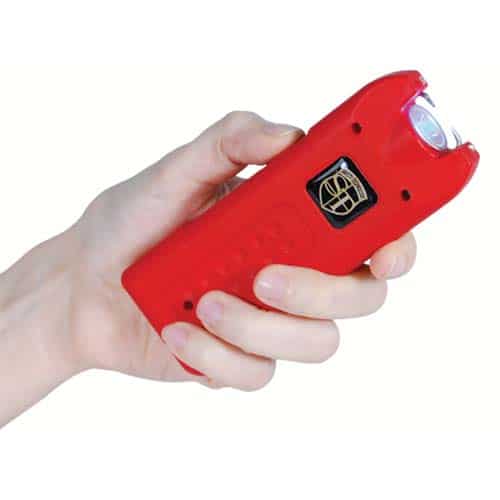Stun Guns Have Fewer Legal Hurdles
Are stun guns good for self defense? Absolutely, stun guns are a strong choice for self-defense. They incapacitate attackers by disrupting their nervous system, giving you a chance to escape. Stun guns work best in close encounters, ensuring that if you’re cornered, you’re not defenseless. They’re important, require direct contact, and are legal with fewer hurdles compared to Tasers in many areas. However, it’s vital to be aware of your local laws and make sure you’re trained in their use. Being prepared means holding a reliable tool that provides peace of mind and safety. Explore more to equip yourself with the knowledge to stay safe and empowered.
Key Takeaways
- Stun guns provide a non-lethal means of temporarily incapacitating an attacker, enhancing personal safety.
- They require close contact for use, limiting their effectiveness at a distance but effective in close-range defense scenarios.
- Proper training and understanding of legal considerations are essential for responsible and effective use.
- Stun guns are cost-effective and portable, making them a practical option for everyday carry.
- They offer a direct approach to self-defense, giving individuals control in uncertain situations without causing lasting harm to the attacker.
Understanding Stun Guns

Stun guns, deploying a low-level electrical current, swiftly disrupt an attacker’s nervous system without inflicting permanent damage, making them a reliable choice for self-defense. Unlike pepper spray, which can be affected by wind direction and requires precise aim, stun guns offer a more direct approach. You’re not just waiting for an attacker to feel the burn; you’re temporarily immobilizing them, buying precious time to escape. It’s essential, however, to understand the law surrounding their use in your area, as self-defense laws vary widely. The Multiguard 80 million volt stun gun, available at nittanyselfdefense.com, is pictured above and is one of our more popular models.
When you’re cornered, the immediate application of a stun gun can be the difference between a close call and a call for help. They’re designed for close encounters, ensuring that if someone’s threatening your safety, a quick, assertive response is right at your fingertips. Remember, the goal is protection, not punishment. By focusing on stopping the attacker rather than causing harm, stun guns embody the principle of judicious self-defense. They’re a powerful tool in your arsenal, offering peace of mind in uncertain situations. So, before you step out the door, consider whether carrying one could make you feel safer. It’s about taking control, responsibly and effectively.
You can watch an informative video about what makes stun guns a good choice for self defense
Stun Gun Versus Taser
Now, you’ve got to contemplate the operational differences and legal considerations between stun guns and Tasers.
You’re not just selecting a self-defense tool; you’re choosing the best fit for your lifestyle and safety needs.
Understand their distinct roles and regulations to confidently make an informed decision that empowers you.
Operational Differences
Understanding the operational differences between stun guns and Tasers is essential when deciding which is best for your self-defense needs.
| Feature | Stun Gun | Taser |
|---|---|---|
| Range | Direct Contact | Safe Distance |
| Method | Overworks Muscles | Uses Probes Attached via Cords |
| Cost | More Cost-Effective | Higher Initial Cost |
| Effectiveness | Close-Range Protection | Greater Electrical Range |
If you’re looking for a way to use a stun gun, you’ll need to be close to an attacker, making it a choice for self-protection when you’re in tight spaces. On the other hand, Tasers allow you to repel attackers from a safe distance, offering a broader range of defense. Consider your needs carefully before making a choice.
Legal Considerations
Before you decide to purchase a stun gun or Taser for self-defense, it’s important to know the legal landscape governing their use in your area. Stun guns and Tasers, while both effective, face different legal hurdles. Most states allow stun guns for civilian use, but Tasers? They’re a bit more complicated, facing more restrictions and outright bans in some places.
Why the difference? Tasers, often used by local law enforcement, can be deployed from a distance, unlike stun guns which must be used in close proximity. This tactical advantage makes Tasers vs. stun guns a critical consideration. Before making your choice, make sure you’re up to speed with local laws. It’s about keeping yourself both safe and legally compliant.
Legal Considerations
When contemplating a stun gun for self-defense, it’s important to familiarize yourself with your state’s legal requirements and restrictions. Stun guns, including TASER® devices, are legal for self-defense use in most states in the U.S. However, some states may impose restrictions on the voltage or specific features of these self-defense weapons. This means you’ve got to delve into the local laws to make sure you’re on the right side of the law.
Knowing where and how you can carry and use a stun gun or taser is vital. It’s not just about having a powerful tool in your hand; it’s about understanding the legal considerations surrounding its use. Remember, using a stun gun in self-defense should always be a last resort, reserved for truly dangerous situations.
Moreover, getting proper training and understanding the self-defense laws in your area isn’t just recommended; it’s essential. It ensures you’re prepared, both mentally and legally, to use these devices effectively and responsibly. So, take the time to educate yourself on the legalities and train in the use of stun guns or TASER® devices. It’s your right and responsibility to protect yourself, but it’s equally important to do so within the bounds of the law.
Safety and Risks
Given the importance of self-defense, it’s important to weigh the safety and risks associated with stun gun use. Stun guns, designed to temporarily incapacitate an attacker, are a popular choice for self-defense. However, they come with their own set of considerations to guarantee your safety and compliance with the law.
- Stun guns can effectively immobilize an attacker, giving you a critical window to escape danger. When used correctly, they’re designed not to cause lasting harm, focusing on your immediate safety.
- Safety mechanisms are built into stun guns to prevent accidental discharge. These features are crucial for protecting you from unintended harm and ensuring the device is ready when you really need it.
- Familiarizing yourself with local laws regarding stun gun possession and use is important. Regulations vary widely, and staying informed helps you avoid legal issues while defending yourself.
- Proper training is crucial. Understanding how to use your stun gun confidently and effectively minimizes risks to yourself and maximizes your ability to protect yourself in threatening situations.
Effective Usage Techniques
Mastering the correct grip and stance is your first step toward effectively wielding a stun gun for self-defense.
By aiming for essential areas, you’ll maximize the device’s potential to stop an attacker in their tracks.
Proper Grip and Stance
To effectively defend yourself with a stun gun, it’s crucial to maintain a firm grip with your dominant hand and adopt a stable, shoulder-width stance. This proper grip and stance are foundational for effective self-defense, ensuring you can use stun guns with precision while keeping a safe distance from an attacker.
- Maintain a firm grip on the stun gun with your dominant hand, keeping your non-dominant hand free for balance.
- Adopt a stable, balanced stance with feet shoulder-width apart for control and accuracy.
- Keep the stun gun at chest level for best reach and visibility.
- Practice regularly in simulated scenarios to improve muscle memory and reaction time.
Targeting Vital Areas
Why should you aim for important areas like the neck, groin, or stomach when using a stun gun for self-defense?
Hitting these sensitive zones, rich in nerve clusters, can swiftly incapacitate an attacker, giving you the chance to escape.
You’re not just poking randomly; you’re targeting the body’s weak spots for maximum effect. Areas with less muscle or fat let the stun gun’s shock do its job more efficiently.
Remember, it’s about your safety.
If you’re unsure about how to effectively use your stun gun, don’t hesitate to contact your local law enforcement or security professionals for advice.
They can guide you on how to carry one confidently.
And always make sure to regularly check and replace your weapon to keep it ready for action.
Purchasing Advice
When considering the purchase of a stun gun for self-defense, keep in mind the device’s size, voltage, and how easy it’s to use. Tasers can be used as a better option for some, worth noting if you’re looking for a device that can incapacitate an attacker from a distance. They require a bit more precision but can give you a vital amount of time to escape.
Here are a few tips to guide your purchase:
- Look for a stun gun with a high voltage to make sure it has the stopping power needed.
- Consider the size and how easily you can carry it. Compact models are great for everyday carry.
- Check the ease of use under stress. You want a stun gun that you can operate quickly if needed.
- Understand the legal requirements in your area for carrying and using a stun gun for self-defense.
Frequently Asked Questions
Are Stun Guns Effective in Self-Defense?
Yes, stun guns can be effective in self-defense, but you should consider legal implications, undergo safety training, understand psychological effects, and check the battery life to make sure they’re ready when you need them.
What Are the Disadvantages of a Stun Gun?
Stun guns have their drawbacks, including legal restrictions, battery dependency, psychological impact, and limited range. You’re at risk of close contact harm, ineffective defense against multiple attackers, and potential escalation of violence.
Which Is Stronger Taser or Stun Gun?
Tasers are stronger than stun guns due to their higher voltage difference, legal usage in more areas, and being powered in a way that allows for longer range attacks compared to direct-contact stun guns.
Can a Stun Gun Stop an Attacker?
Yes, a stun gun can stop an attacker through electric shock, causing pain and muscle spasms. The duration and voltage variation affect recovery time. However, you’ll need to take into account legal restrictions before using one.


